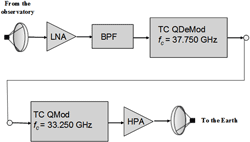6. System Design:
a. Satellite : The system consists of one relay satellite which has a two dish antennas with a radius of 1.5 meters and an aperture efficiency of 0.65. The satellite will be equiped with solar cells to derive the power needed for the electrical systems and rocket motor for station keeping maneuvers. Since the satellite will be stationed at a halo orbit and will have to make station keeping maneuvers constantly the biggest disadvantage of the system is that lifetime of the satellite depends on the fuel consumption for station keeping and period control maneuvers.
b. Communication Links :
i . Lunar Observatory : The measurements of the lunar radio telescope is transmitted to the earth station. The analog data signals are sampled and quantized and a bit stream is formed. QPSK modulation scheme is used in the system with turbo codes. The input signal is encoded by the turbo coder. The encoded signal is mapped to the symbols for the in-phase and quadrature channels of the QPSK modulator. The output of the QPSK modulator is transmitted in the RF channel by the the uplink carrier frequency.

Figure 12 : Turbo Code QPSK modulation

Figure 13 : Turbo Code QPSK demodulation

Figure 14 : Transmitted signal from the observatory
ii. Relay Satellite : The transmission of the observatory is received by the relay satellite. The signal is amplified and band-pass filtered. The base band signal is low-pass filtered,amplified and demodulated from QPSK. The decoded signal is sent to the turbo coder and modulated to the downlink carrier frequency, amplified and sent to the earth.

Figure 15 : Relay of the information by the satellite
iii. Earth Station : The signals received at the earth station are low-pass filtered, amplified, demodulated into baseband and decoded to receive the measurements of the observatory.

Figure 16 : Received signal at earth station